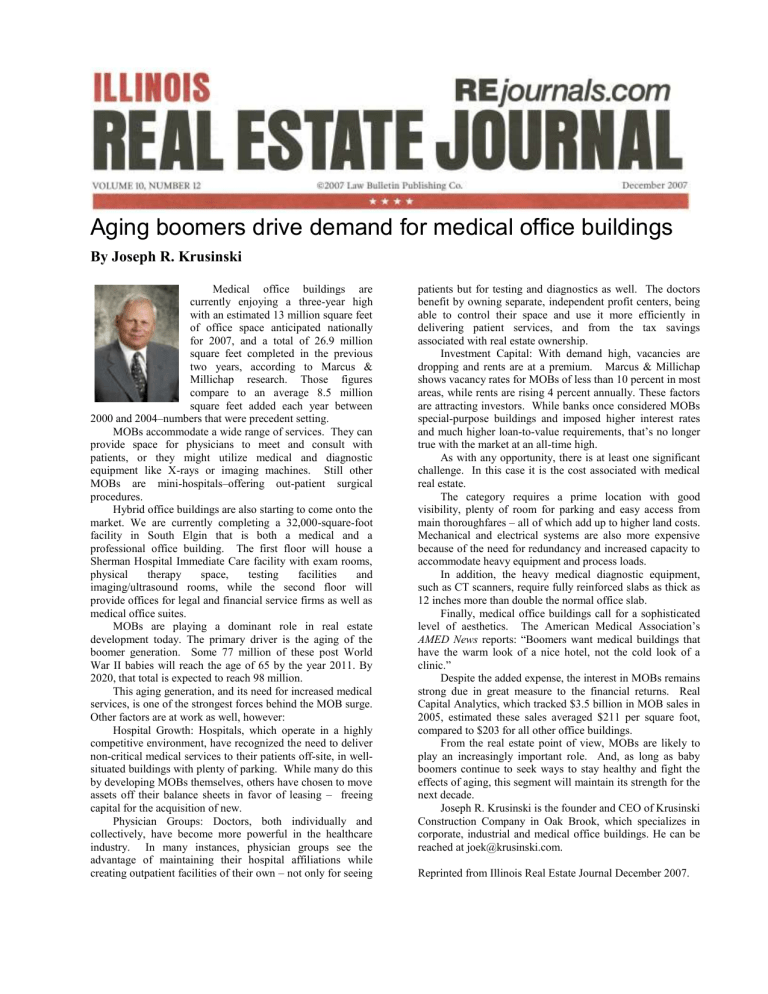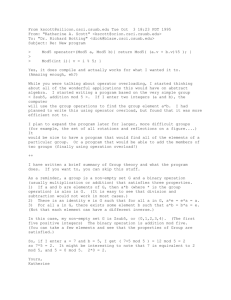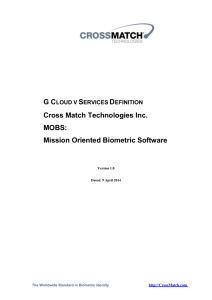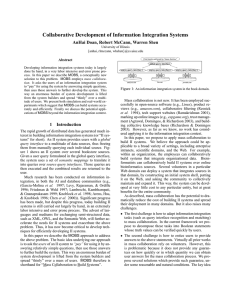Medical Office Buildings - Krusinski Construction Company

Aging boomers drive demand for medical office buildings
By Joseph R. Krusinski
Medical office buildings are currently enjoying a three-year high with an estimated 13 million square feet of office space anticipated nationally for 2007, and a total of 26.9 million square feet completed in the previous two years, according to Marcus &
Millichap research. Those figures compare to an average 8.5 million square feet added each year between
2000 and 2004–numbers that were precedent setting.
MOBs accommodate a wide range of services. They can provide space for physicians to meet and consult with patients, or they might utilize medical and diagnostic equipment like X-rays or imaging machines. Still other
MOBs are mini-hospitals–offering out-patient surgical procedures.
Hybrid office buildings are also starting to come onto the market. We are currently completing a 32,000-square-foot facility in South Elgin that is both a medical and a professional office building. The first floor will house a
Sherman Hospital Immediate Care facility with exam rooms, physical therapy space, testing facilities and imaging/ultrasound rooms, while the second floor will provide offices for legal and financial service firms as well as medical office suites.
MOBs are playing a dominant role in real estate development today. The primary driver is the aging of the boomer generation. Some 77 million of these post World
War II babies will reach the age of 65 by the year 2011. By
2020, that total is expected to reach 98 million.
This aging generation, and its need for increased medical services, is one of the strongest forces behind the MOB surge.
Other factors are at work as well, however:
Hospital Growth: Hospitals, which operate in a highly competitive environment, have recognized the need to deliver non-critical medical services to their patients off-site, in wellsituated buildings with plenty of parking. While many do this by developing MOBs themselves, others have chosen to move assets off their balance sheets in favor of leasing – freeing capital for the acquisition of new.
Physician Groups: Doctors, both individually and collectively, have become more powerful in the healthcare industry. In many instances, physician groups see the advantage of maintaining their hospital affiliations while creating outpatient facilities of their own – not only for seeing patients but for testing and diagnostics as well. The doctors benefit by owning separate, independent profit centers, being able to control their space and use it more efficiently in delivering patient services, and from the tax savings associated with real estate ownership.
Investment Capital: With demand high, vacancies are dropping and rents are at a premium. Marcus & Millichap shows vacancy rates for MOBs of less than 10 percent in most areas, while rents are rising 4 percent annually. These factors are attracting investors. While banks once considered MOBs special-purpose buildings and imposed higher interest rates and much higher loan-to-value requirements, that’s no longer true with the market at an all-time high.
As with any opportunity, there is at least one significant challenge. In this case it is the cost associated with medical real estate.
The category requires a prime location with good visibility, plenty of room for parking and easy access from main thoroughfares – all of which add up to higher land costs.
Mechanical and electrical systems are also more expensive because of the need for redundancy and increased capacity to accommodate heavy equipment and process loads.
In addition, the heavy medical diagnostic equipment, such as CT scanners, require fully reinforced slabs as thick as
12 inches more than double the normal office slab.
Finally, medical office buildings call for a sophisticated level of aesthetics. The American Medical Association’s
AMED News reports: “Boomers want medical buildings that have the warm look of a nice hotel, not the cold look of a clinic.”
Despite the added expense, the interest in MOBs remains strong due in great measure to the financial returns. Real
Capital Analytics, which tracked $3.5 billion in MOB sales in
2005, estimated these sales averaged $211 per square foot, compared to $203 for all other office buildings.
From the real estate point of view, MOBs are likely to play an increasingly important role. And, as long as baby boomers continue to seek ways to stay healthy and fight the effects of aging, this segment will maintain its strength for the next decade.
Joseph R. Krusinski is the founder and CEO of Krusinski
Construction Company in Oak Brook, which specializes in corporate, industrial and medical office buildings. He can be reached at joek@krusinski.com.
Reprinted from Illinois Real Estate Journal December 2007.










